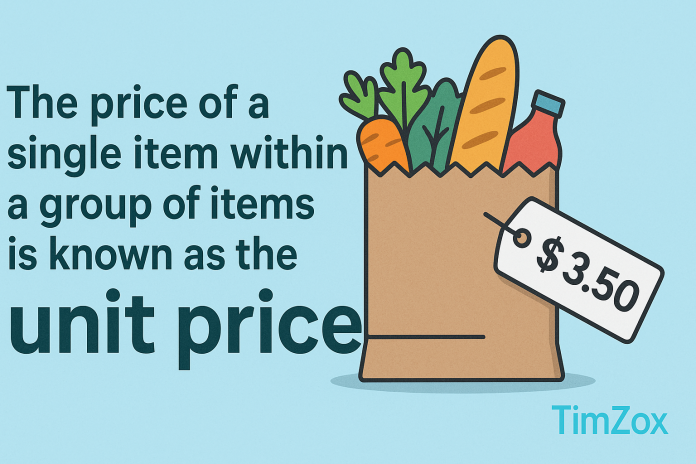Have you ever stood in a grocery aisle, comparing two different packages of cereal, unsure which one actually offers better value? Or maybe you’ve reviewed supplier quotes at work and needed to choose the most cost-effective option.
In both cases, you were actually solving the same puzzle—figuring out the unit price.
The price of a single item within a group of items is known as the unit price of the item.
While that sentence might sound like a definition you’d hear in school, it holds real, practical power. Understanding unit price helps you make smarter financial decisions, whether you’re shopping for groceries, managing a business, or pricing a product.
This article will explain what unit price is, why it’s so important, how to calculate it, and how to apply it across multiple industries—with practical examples, expert tips, and real-world relevance.
What Does “Unit Price” Mean?
Unit price refers to the cost of one single unit of a product or service, even when it’s sold as part of a larger group or bundle.
To put it simply:
The price of a single item within a group of items is known as the unit price of the item.
This simple concept allows consumers and businesses to compare values even when the total prices and quantities differ.
📌 Formula:
Example:
If a 6-pack of soda costs $4.50:
Knowing this helps you quickly judge whether a 12-pack for $8.80 is worth it. (Spoiler: It’s not—because the unit price is $0.73, only slightly cheaper.)
Why Understanding Unit Price Is a Game-Changer
1. Smarter Consumer Choices
When you’re buying toothpaste, rice, paper towels, or any packaged goods, the unit price cuts through marketing noise like “jumbo” or “family-size” and lets you see what you’re actually paying per item, per ounce, or per liter.
2. Business and Inventory Optimization
In business, especially in procurement and manufacturing, the unit price is critical for:
-
Budgeting and cost control
-
Supplier comparison
-
Pricing strategy
-
Profit margin analysis
3. Transparency and Fairness
Many regulatory bodies even require supermarkets to display unit prices on shelf labels. Why? Because they help level the playing field—ensuring consumers aren’t misled by bulk packaging or tricky pricing.
Different Types of Unit Price
| Type | Where It’s Used | Example |
|---|---|---|
| Per item | Supermarkets, retail | $1.25 per bottle of water |
| Per kilogram/liter | Produce, liquids | $2.50/kg for rice |
| Per hour | Services, consulting | $60/hour for legal work |
| Per square foot | Real estate | $350/sq. ft. office space |
| Per gigabyte | Cloud services, data plans | $0.10/GB of storage |
Unit Price in Everyday Life: Examples That Matter
🛒 Grocery Shopping
You’re buying detergent:
-
Brand A: $10 for 2L → $5/L
-
Brand B: $12 for 3L → $4/L
Brand B is the better deal, even though it costs more upfront.
🏗️ Manufacturing
You’re sourcing metal parts:
-
Supplier X: $900 for 300 parts = $3/unit
-
Supplier Y: $850 for 250 parts = $3.40/unit
Even though Supplier Y is cheaper overall, Supplier X gives a better unit price—making it a smarter long-term choice.
When Bigger Isn’t Better
Let’s bust a myth: buying in bulk is not always cheaper per unit.
Retailers sometimes charge more per unit for larger packages because of perceived value or convenience. Always check the unit price label—or calculate it yourself.
Tools to Help You Calculate Unit Price
| Tool | Use Case |
|---|---|
| Smartphone calculator | Quick in-store math |
| Excel or Google Sheets | Track large datasets or supplier quotes |
| Retailer-provided shelf labels | Most grocery stores include unit price |
| Shopping apps (like Basket, ShopSavvy) | Scan barcodes for comparisons |
| Procurement software | For enterprise use (e.g., SAP Ariba, Coupa) |
Unit Price and E-Commerce
In online shopping, Amazon, Walmart, Target, and others now display unit prices for bulk or multi-pack items. This helps users compare deals and contributes to higher trust and conversion rates.
Tip for sellers: Transparent unit pricing = higher credibility. It can directly impact SEO rankings and purchase intent.
How Businesses Use Unit Pricing
1. Procurement & Sourcing
Procurement teams compare vendors using unit price tables to evaluate who offers better value—not just lower total cost.
2. Dynamic Pricing
E-commerce retailers may adjust unit prices in real-time using demand-based pricing algorithms.
3. Service Billing
Freelancers, agencies, and consultants often use a “unit” of time (hour/day) to standardize billing.
The Psychology Behind Unit Price
Studies show that clear unit pricing improves consumer trust and reduces decision fatigue.
In a 2022 NielsenIQ study:
-
64% of consumers said they prefer shopping at stores that clearly display unit prices.
-
Unit price comparison reduced shopping time by up to 15%.
Frequently Asked Questions (FAQs)
❓ What is the unit price of a product?
It’s the cost of a single unit of an item when sold in a group. For example, $0.50 per battery in a 10-pack for $5.
❓ Is unit price the same as unit cost?
No. Unit price is what the consumer pays; unit cost refers to how much it costs the company to produce or acquire the item.
❓ Why is it important to compare unit prices?
It allows you to find the best value regardless of total price or packaging size.
Read Also: Competitive Edge The Serpentrogue in Alchemy & Strategy
Conclusion: The Power of Knowing the Unit Price
To wrap it all up:
The price of a single item within a group of items is known as the unit price of the item.
That one line can transform the way you shop, price, or manage costs.
Whether you’re buying coffee pods, sourcing industrial components, or budgeting for groceries—knowing the unit price gives you clarity, control, and confidence. It’s a tool that empowers everyday consumers and high-level professionals alike.


